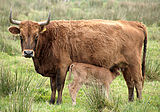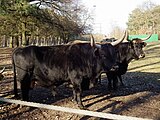Heck cattle
This article relies largely or entirely on a single source. (May 2021) |
 Heck bull, cow and calf | |
| Country of origin | Germany |
|---|---|
| Distribution | Europe, especially Central and Western Europe |
| Use | grazing projects; in zoos, agriculture |
| Traits | |
| Weight |
|
| Height |
|
| Coat | varied shadings of red, brown, black |
| Horn status | Horned, diverse shapes, directions and sizes |
| |



Heck cattle are a hardy breed of domestic cattle. These cattle are the result of an attempt by the Heck brothers to breed back the extinct aurochs (Bos primigenius) from modern aurochs-derived cattle in the 1920s and 1930s. Controversy revolves around methodology and success of the programme.[1] There are considerable differences between Heck cattle and the aurochs in build, height, and body proportions. Furthermore, there are other cattle breeds which resemble their wild ancestors at least as much as Heck cattle.[1]
History[]
Heck cattle originated in Germany in the 1920s and 1930s in an attempt to breed back domestic cattle to their ancestral form: the aurochs (Bos primigenius primigenius).[2] In the first years of the Weimar Republic, the brothers Heinz and Lutz Heck independently started their extensive breeding-back programmes.[3]
Their motivation was to rescue the aurochs from oblivion because it was constantly confused with the wisent, the other large bovine of Holocene Europe. The Heck brothers believed that creating a look-alike and showing both species next to each other would help to show the difference between the two species to a broader public. Apart from that, they believed they were able to reconstruct the species and therefore to correct the mistake man made when killing the species off.[4]
Heinz was the director of the Hellabrunn Zoological Gardens in Munich and Lutz of the Berlin Zoological Gardens. Only eleven years after they started their breeding experiments, just as the Weimar Republic was drawing to a close, they each announced success.[5][6] The two brothers used different selections of cattle breed in their breeding-back attempts. For example Lutz Heck (in Berlin) used Spanish fighting bulls whilst Heinz Heck (in Munich) did not.[1] The Berlin breed seemingly did not survive the Second World War, so all modern Heck cattle go back to the experiments of Heinz Heck in Munich.[1] The ancestral breeds used include:
- Hungarian Grey Cattle
- Highland Cattle
- Corsican Cattle
- Murnau-Werdenfels Cattle
- Angeln cattle
- Black-pied lowland cattle
- White Park Cattle
- Brown Swiss
In 1932 the first bull that Heinz Heck believed to resemble the aurochs was born and named Glachl. He was a 75% Corsican and 25% (Gray cattle × Lowland × Highland × Angeln) cross. This bull and his father were subsequently bred into further breeds to increase weight.[1] As a consequence most modern Heck cattle go back to Central European dairy and beef cattle that were supplemented by cattle from other regions.[7] Advocates of Heck cattle often claim that Heinz′ and Lutz′ breeding results looked largely identically, thus ″proving the success″ of their experiment. However Berlin and Munich Heck cattle did not look very similar.[1]
Distribution[]
There are about 2000 Heck cattle in Europe and few elsewhere. Heck cattle are found in German zoos because of the erroneous claim by the Heck brothers that these cattle represent resurrected aurochs and are suitable for conservation projects today. In Oostvaardersplassen in Flevoland (Netherlands), about 600 Heck cattle roam freely. Weak animals are shot by hunters in order to prevent unnecessary suffering.[8] Others are at the Falkenthaler Rieselfelder near Berlin, at the Nesseaue nature reserve near Jena, Thuringia and at the Grubenfelder Leonie nature reserve in Auerbach, Bavaria. About 100 were registered in France in 2000. In 2009 Derek Gow, a British conservationist who operates a rare breeds farm at Lifton in Devon, bought a herd of 13 Heck cattle from Belgium in 2009.[9][10] The herd grew to 20 animals, but in 2015 Gow slaughtered all but six due to handling problems.[11]
Criticism[]
Criticism of the methodology and result of the Heck brothers' programs dates back to at least the 1950s. Cis van Vuure describes the work of W. Herre in 1953 and O. Koehler in 1952:
A lack of basic knowledge about the extinct aurochs, broad selection criteria [of breeds chosen to create the cattle]...and the rich imagination and complacency of the two brothers led to their excessive simplification of the breeding-back procedure.
Criticism also focused on the carelessness, the ease and the speed with which they had carried out their experiments as well as the genetic basis.[12] Cis van Vuure further stated that:
On account of the absence of any marked similarity in size, colour and horn shape, among other aspects, Heck cattle cannot be considered to resemble the aurochs closely. Rather they should be seen as a population of cattle in which a few aurochs characteristics may be found; a trait they share with many other cattle populations.
In the view of some experts, primitive Southern European cattle breeds are much closer overall to the aurochs than Heck cattle, such as the Spanish fighting bull.[1]
Characteristics[]
A typical Heck bull should be on average 1.4 metres (55 in) tall, and a cow 1.3 metres (51 in), with weight up to 600 kg (1300 lb). Heck cattle are twenty to thirty centimeters shorter than the aurochs they were bred to resemble. Heck bulls are not larger than other domestic bulls and actually a little smaller than cattle used in modern intensive agriculture,[1] whilst aurochs bulls reached shoulder heights of between 160 and 180 and in rare cases even 200 cm. Aurochs bulls are believed to have weighed some 700 to 1000 kg (1500 to 2200 lb).[1]
Size is not the only aspect in which Heck cattle differ from their wild ancestor. Heck cattle are bulky like many other domestic breeds, whilst the aurochs, as a wild bovine, had an athletic body shape. The legs of Heck cattle are shorter and the trunk much longer than in the aurochs, in which shoulder height and trunk length nearly equalled each other.[1] Heck cattle have a comparatively small and short head, whilst aurochs had a large elongated head sitting on a muscular neck. Aurochs had well-developed shoulder musculature, carried by long spines, which is absent in Heck cattle. All in all, proportions and body shape of Heck cattle are not significantly similar to the aurochs and do not differ from many other domestic breeds.[1]
The horns of the aurochs had a characteristic and relatively stable shape. At the base they grew outwards-upwards, then forwards-inwards and inwards-upwards at the tips. Aurochs horns were large and thick overall, reaching 80–100 cm in length and 10 cm or more in diameter.[4] However the horns of Heck cattle differ in many respects. Usually they curve too much upwards or outwards compared with the original or do not reach the length or diameter of the aurochs. Often the horns of Heck cattle strongly resemble the breeds it was created from (i.e. Grey Cattle).[1]
In coat colour Heck cattle may resemble the aurochs, the bulls having a black overall coat colour with a light eel stripe and cows displaying a reddish-brown colour. However some Heck bulls may have a light-coloured saddle (which was apparently not present in the European aurochs) and the sexual dimorphism in colour is unclear in most cases; bulls and cows may be dark with a light-coloured saddle, black cows appear regularly and light-coloured bulls are no rarity. There are other deviant colours too, such as individuals having a grayish or gray colour and cows being beige. White patches, typical of pied dairy breeds, appear as well, sometimes to the same extent as in Holstein cattle.[1]
Heck cattle demonstrate a higher amount of heterogeneity than any wild animal or most other domestic breeds. There is considerable variation in coat colour, horn shape and horn dimensions, as well as size and proportions. Besides the features that are desired because they bear resemblance to the aurochs, numerous divergent features may appear (as explained above).
Heck cattle differ in many respects from the aurochs, and there are breeds that resemble the aurochs at least as much, such as the Spanish fighting bull.[2] Nevertheless they are capable of coping in the wild with cold temperatures or nutrient-poor food. On the other hand there are other robust cattle breeds that cope with harsh conditions at least as well as Heck cattle and feral cattle are no rarity.[1]
Use[]
Heck cattle have been used in breeding-back projects such as the German Projekt Taurus, aimed at creating cattle with closer similarity to the aurochs.[13][14]

|

|

|

|

|
See also[]
References[]
| Wikimedia Commons has media related to Heck cattle. |
- ^ Jump up to: a b c d e f g h i j k l m n van Vuure, Cis (2005) Retracing the Aurochs - History, Morphology and Ecology of an extinct wild Ox. ISBN 954-642-235-5
- ^ Jump up to: a b van Vuure, Cis (2005) Retracing the Aurochs - History, Morphology and Ecology of an extinct wild Ox. ISBN 954-642-235-5
- ^ Heck, H. (1951). "The Breeding-Back of the Aurochs". Oryx. 1 (3): 117. doi:10.1017/S0030605300035286.
- ^ Jump up to: a b Walter Frisch: Der Auerochs - Das europäische Rind. 2010, ISBN 978-3-00-026764-2.
- ^ Heinz Heck (1934): ″Der Ur.″ Das Tier und Wir, Monatszeitschrift für alle Tierfreunde. Special edition (Sondernummer), March 1934. Quoted in: T. van Vuure, ″History, Morphology and Ecology of the Aurochs (Bos primigenius),″ 2002.
- ^ Lutz Heck (1934): ″Über die Neuzüchtung des Ur oder Auerochs.″ Berichte der Internationalen Gesellschaft zur Erhaltung des Wisents 3(4):225–294, 1934. Quoted in: T. van Vuure, ″History, Morphology and Ecology of the Aurochs (Bos primigenius),″ 2002.
- ^ Julia Poettinger: Vergleichende Studie zur Haltung und zum Verhalten des Wisents und des Heckrinds. 2011.
- ^ "Map taken from the "Staatsbosbeheer Oostvaaderplassen information" leaflet". Archived from the original on 2008-11-22. Retrieved 2008-04-10.
- ^ Report by the Independent newspaper Retrieved 2009-04-22
- ^ "'Nazi super cows are trying to kill everyone,' says Devon farmer - Plymouth Herald". Plymouth Herald, archived copy on Internet Archive. Archived from the original on 8 January 2015. Retrieved 6 January 2015.
- ^ Steven Morris. "Devon farmer forced to offload aggressive Nazi-bred 'super cows'". The Guardian. Retrieved 6 January 2015.
- ^ History, Morphology and Ecology of the Aurochs (Bos primigenius), T. van Vuure, Lutra 2002.
- ^ Uffe Gjøl Sørensen: Vildokserne ved Lille Vildmose 2003–2010. Status rapport med anbefalinger til projektets forvaltning. Archived 2013-11-14 at the Wayback Machine København: UG Sørensen Consult, 2010.
- ^ Margret Bunzel-Drüke: ″Projekt Taurus – En økologisk erstatning for uroksen.″ Archived 2011-10-17 at the Wayback Machine Translated into Danish by Karsten Thomsen. Lohne: ABU 2004; Århus: Nepenthes, 2005.
- International Commission on Zoological Nomenclature. 2003. Opinion 2027 (Case 3010). Usage of 17 specific names based on wild species which are pre-dated by or contemporary with those based on domestic animals (Lepidoptera, Osteichthyes, Mammalia): conserved. Bull.Zool.Nomencl., 60:81-84.
- Vuure, C. van. 2005. Retracing the Aurochs: History, Morphology and Ecology of an Extinct Wild Ox. Pensoft Publishers. Sofia-Moscow.
- Vuure, C. van. 2002. History, Morphology and Ecology of the Aurochs (Bos primigenius)
External links[]
| Wikimedia Commons has media related to Heck cattle. |
- Modern German Heck cattle (in German)
- 'Nazi' cattle being bred in UK BBC News (video) on introduction of Heck cattle to Devon, UK, 2009-04-26
- Cattle breeds
- Cattle crossbreeds
- Cattle breeds originating in Germany
